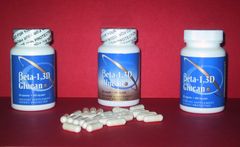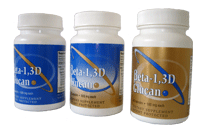Beta Glucan
Beta glucan is a natural polysaccharide consisting of numerous molecules of glucose connected together in a 1,3 beta configuration. Polysaccharides in general, and beta glucans in particular, have a long history as immunomodulators (under the “term immunomodulator” we recognize substances which support and modulate the immune system), and have been tested and researched for decades. The first investigation of the tumor-reducing effects of a polysaccharide called Shear’s polysaccharide was published more than 60 years ago. Decades later, more interest was created after published experiments showing that crude yeast cell preparations called “zymosan” stimulate macrophages via the activation of the complement system. After that, the attention of numerous investigators focused directly on beta glucan and it was soon established that beta glucans have both antibacterial and anti-tumor properties.
In the middle of the 80ies, two basic types of glucan, lentinan and schizophyllan, were licenced in Japan as immuno-stimulants effective in cancer therapy. Lentinan is isolated from Lentinus edodes, and schizophyllan is obtained from the cultural fluid of Schizophyllium commune.
The Immune System

The Immune system consists of numerous components which not only are constantly on alert to find the invading pathogens, but also to find means of destroying eliminating them from our body. Generally, there are three different types of cells involved in immune reactions. The first line of defense is formed by the macrophages. These cells are present in every single organ of our body, from the peripheral blood to various organs such as the spleen, the lymph nodes, the liver, the skin or the brain, and constantly monitor their surroundings for anything which they consider foreign. Invading microorganisms, mutated or damaged cells, or even macroscopic material such as small parts of wood or dust, are considered foreign and potentially harmful. The importance of the macrophages can be further stressed by the fact that these cells are the evolutionary oldest and best preserved defensive cells, and there is no living creature on Earth which does not depend on macrophages for its immune reactions.
In order to fulfill their defensive duties, macrophages have to change from a “steady-state” to an “activated state”. Only after becoming fully activated can macrophages perform their numerous functions. The basic function of macrophages is to analyze the situation, recognize the invading prey and to phagocytose it. Subsequently, the ingulfed material is destroyed by potent intracellular enzymes. But macrophages can do even more, using the ability to produce and actively secrete numerous factors involved in the direct destruction of the attacking bacteria. This results in the destruction of a significant part of the invading pathogens.
The cellular branch of immune reactions has another ace up its sleeve, called “T lymphocyte”. These small cells are acting in close cooperation with the macrophages and when activated, they seek and kill not only viruses, but also cancer cells. Lymphocytes activation via the network of macrophages or through some specific drugs can become the so called “NK cells”. These cells have one and only purpose – to recognize and kill dangerous cells, which result from either viral infections or cancerogenic mutations. They really represent a bloodthirsty subtype of lymphocytes.
An additional cell type involved in immune reactions is the B lymphocytes. These cells are responsible for the production and secretion of highly specific antibodies, which subsequently recognize bacteria and guide macrophages and T lymphocytes towards objects coated with them. Antibodies therefore act as some kind of targeting devices which put a bull’s eye on the membrane of the cells and microorganisms which our body is trying to get rid of. When macrophages and lymphocytes are not enough, our body has an additional systems on alert. As an example, we can mention systems such as properdin or the complement cascade.
All these cell types do not act alone, but in a symphony. These cells constantly interact with each other and act upon the information transferred via a complicated network of humoral factors such as enzymes and cytokines.
Different Types of Glucan
During decades of research, numerous types of glucan have been isolated and described. Unfortunately, not all glucans were created equal and glucans differ widely, not only in physicochemical properties such as branching or molecular weight, but also in biological properties. Some of the described glucans had no biological activities at all. Due to the easy availability and biological consistency of yeasts, they soon became the main focus of attention. Again, various types of glucans can be isolated from almost every species of yeast. More recent studies, however, have shown that beta glucan isolated from baker’s yeast Saccharomyces cerevisiae exhibits the most powerful and most positive biological effects. Most researchers now regard this form of glucan to be the most reliably and consistently effective. The added advantage is the fact that baker’s yeast–derived glucan is less expensive to manufacture and isolate than others. In addition, beta-glucan isolated from baker’s yeast is a highly purified substance, where all potentially allergenic proteins and polysaccharides have been removed.
How Glucan Works

- As we mentioned above, in order to be able to fully respond to all invading microorganisms, macrophages need to become activated. Only after several steps of the activation cascade does a whole sequence of metabolic changes occur, together with changes on the membrane of macrophages. In many cases, the attacking bacteria, either directly or indirectly via toxins such as endotoxin, activate macrophages by themselves. Unfortunately, quite often this natural activation is not enough. Sometimes the bacteria do not adequately activate macrophages, sometimes the whole immune system is weakened and the number of macrophages is exhausted.
- Clearly, our immune system needs help, and this is where glucan comes to help. It is able to help our immune system in two completely different ways. First, glucan is taking care about the number of cells involved in immune reactions. All these cells originate from common precursors found in the bone marrow. The influx of new cells from the bone marrow is steady, but limited. And here, beta glucan comes to the rescue. It stimulates the production of precursor cells in the bone marrow, resulting in a more rapid flow of new cells into the bloodstream and into all lymphoid organs.
- Beta glucan also interacts directly with the macrophages and represents one of their strongest activators. Upon the binding of glucan to the specific receptor present on the membrane of macrophages, macrophages become activated and able to perform with maximum capacity.
- Beta glucan is also involved in the fight against cancer. Despite the fact that most tumors are recognized by the immune system, the antibody response is usually not strong enough to destroy the cancer growth. Even a fully healthy immune system cannot adequately deal with fast-growing cancer cells. Beta glucan is able to cooperate with antibodies. After the tumor cells are recognized as foreign, specific antibodies are released and subsequently bind to the cancer cells. Following this binding of antibodies, C3 fragments of complement coat the surface of cancer cells, and then the beta glucan-primed cells such as macrophages, NK cells and neutrophils specifically recognize these antibody-C3 coated cells and kill them. Without glucan, the killing will not take place and the situation will get serious very fast.
Our Beta Glucan
Derived from the cell walls of baker’s yeast, our Beta-glucan has been scientifically proven to both maintain and support a healthy immune response. A strong immune system is vital to the preservation of your good health.
